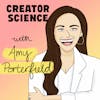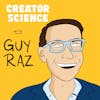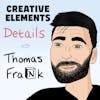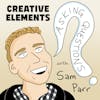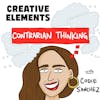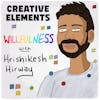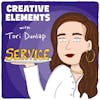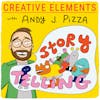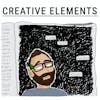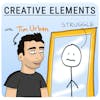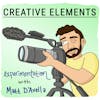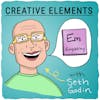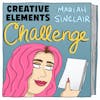
#91: Mariah Sinclair – How the "Queen of Cozy" began designing covers for cozy mystery novels
Play EpisodeNow known as the “Queen of Cozy,” Mariah’s clients regularly dominate the top of the cozy mystery charts on Amazon.
Mariah Sinclair is an award-winning designer. During most of her career, she worked for advertising agencies as a designer and digital marketer serving Fortune 500 companies and the City of Los Angeles. Then she designed her first book cover in 2001. Now known as the “Queen of Cozy,” Mariah’s clients regularly dominate the top of the cozy mystery charts on Amazon.
Today, Mariah sometimes designs hundreds of pre-made covers and lists them for sale at once, earning thousands of dollars within minutes (and sometimes crashing her website in the process).
In this episode, we talk about her first book cover design in 2001 and why it took 14 years to design her second how self-published authors earn their living, the role a book cover plays in the success of a book, how she built up her own clientele, and why always chasing a new Challenge wasn’t always a positive experience.
Learn more about Mariah Sinclair
See some of Mariah Sinclair's pre-made covers
Follow Creative Elements on Instagram
Full transcript and show notes
***
SPONSORS
***
IF YOU LOVE CREATIVE ELEMENTS
Subscribe to weekly episode emails
Leave a review on Apple Podcasts
***
ABOUT JAY CLOUSE
Subscribe to my newsletter, Creative Companion
***
FOR PODCASTERS
Enroll in my podcasting workshop
Enroll in my course on podcasting, Podcast Like The Pros
***
PODGLOMERATE NETWORK
This show is a part of the Podglomerate network, a company that produces, distributes, and monetizes podcasts. We encourage you to visit the website and sign up for our newsletter for more information about our shows, launches, and events. For more information on how The Podglomerate treats data, please see our Privacy Policy.
Since you're listening to Creative Elements, we'd like to suggest you also try other Podglomerate shows surrounding entrepreneurship, business, and careers like Rocketship.fm and Freelance to Founder.
Learn more about your ad choices. Visit megaphone.fm/adchoices
Mariah Sinclair 00:00
I knew how the book cover functioned as a marketing piece, not a representation of the story. And too many authors think it represents the story and it does not.
Jay Clouse 00:13
Welcome to Creative Elements, a show where we talk to your favorite creators and learn what it takes to make a living from your art and creativity. I'm your host Jay Clouse. Let's start the show. Hello my friend, welcome back to another episode of Creative Elements. Last week, the podcast nearly broke into the top 50 shows and the careers category on Apple podcasts, it was our highest chart position in a while. And I would love to keep reaching higher and higher and break that top 50 mark, you can play a really big role in that. If you haven't already, please take a moment to leave a rating or review on Apple podcasts. A high velocity and new ratings and reviews really helps push the show up the charts. And that means good things for both of us. Great guests, great partners, more time and resources to invest into the show. It goes a long, long way. And if you're not an Apple user, please consider leaving a rating on Spotify instead, it's a new feature, you just go to the show page and click the star icon. Speaking of Apple, today on the show, I'm speaking with Mariah Sinclair, an award winning designer who got her start in the 1980s because she was an early user of Apple computers.
Mariah Sinclair 01:38
My summers were spent with my grandparents. And my grandfather had a ELIZA computer. When it was too hot to go swimming in Texas, he would sit me up in the computer and I would probably on the Macintosh who was play with MACPaint or SuperPaint and draw things pixel by pixel. But it was more of a toy for me. It wasn't a computer.
Jay Clouse 02:02
That was Mariah. Her early start learning how to use computers for design helped her to land some really great design gigs early in her career, even without a college education. During most of her early career, she worked for advertising agencies as a designer and digital marketer, serving fortune 500 companies in the city of Los Angeles. As we'll hear in this interview, she even became an art director by age 28, her dream job, but things weren't always good. And her story isn't a story of success, after success, after success. And that's why I'm really excited to share her story here today. I love hosting the show and I love telling the stories of the creators that have appeared on the show. Their stories are all inspiring and they're all encouraging. Sometimes though, these creators make things look really easy. And not every creators journey is easy. They aren't always quick and they aren't always linear. After becoming an art director at age 28, Mariah felt like she needed a new goal, a new path now that she had achieved what she had set out to do. In that pursuit set her down a long and winding road.
Mariah Sinclair 03:09
I moved to locations and then I find work. I jumped into a bunch of different careers. I was a career advisor for a culinary school in San Francisco. I was a talent scout for entertainment at one point. I mean, I had some interesting stories, but there was no gross on a ladder. There was lots of little unconnected things. I'm a Clinical Hypnotherapist actually and tried to have a hypnotherapy business in New Orleans. So I have a lot of these strange little disconnected things while I was trying to find the path in my 30s. The new thing and it was really hard. It didn't come easily. I have great stories at cocktail parties, but that doesn't pay the bills. And it was a hard time.
Jay Clouse 04:00
As you'll hear that hardship landed Mariah back at home with her parents, and though she wasn't happy to be moving back in with her parents at age 40, that decision is actually what started a new path for Mariah. She rediscovered her love for design and specifically she discovered book cover design.
Mariah Sinclair 04:18
I start looking at different genres of covers and I see a cover that says Live and Let Chai. What is that? What is Live and Let Chai? I chuckled because I love puns. And that was my introduction to Cozy Mysteries.
Jay Clouse 04:35
Cozy Mysteries. That is Maria's new home as a book cover designer. Its niche, sure, but it's her niche. In that world of cozy mystery novels, Mariah is known as the Queen of Cozy. So what is a cozy mystery?
Mariah Sinclair 04:50
The things that make a cozy mystery in our day and age right now, obviously a mystery, clean, no bad words, no on screen sex. no gore, they're very sweet. For those of a certain age might remember a TV show called Murder, She Wrote, that is your perfect cozy mystery. Amateur Sleuth, she was an author, not a detective. But she's solving all these crimes, murder, generally. But there was nothing offensive about it other than murder. But even the murder just seems sanitized in some way. And then at the end, justice is served. And you can see in our time right now, why readers might be craving justice. For the last couple of decades, a lot of people have felt that high ranking people have been getting away with stuff. And in these cute little communities where everyone knows each other's name, justice is served and that's very satisfying for the readers.
Jay Clouse 05:56
The cozy mystery genre has been growing a lot over the past few years. Mariah earns hundreds of dollars per hour designing these book covers, and she's built a devoted audience of authors who build stories around her covers. And her clients regularly dominate the top of the cozy mystery charts on Amazon. Today, Mariah sometimes designs hundreds of pre made covers and list them for sale all at once earning 1,000 of dollars within minutes, and sometimes crashing her website in the process. So in this episode, we talk about her first book cover design in 2001 and why it took 14 years to design her second? How self published authors earn their living? The role a book cover plays in the success of a book. How she built up her own clientele? And why always chasing a new challenge hasn't always been a positive experience. I'd love to hear your thoughts on this episode. As you listen, you can find me on Twitter @jayclouse or on Instagram @creativeelements.fm, tag me, say hello, let me know that you're listening. And now let's talk to Mariah.
Mariah Sinclair 07:04
I am of an age where there's a big change in the world in the early 90s, where graphic design moved more to the computer even before that, it was hand done. And so the people that were running agencies who were in their 40s, 50s weren't necessarily computer adapt. And I had started working on a Mac. I mean working as a strong word. I got exposed to Macintosh computers in 1984. Actually, the first Mac I worked on wasn't even a Mac. I sat at ELIZA at nine years.
Jay Clouse 07:42
Wow. Wow.
Mariah Sinclair 07:44
Yeah, yeah. And then when I was in high school, I joined the yearbook staff mainly for writing. I just wanted to write articles for the yearbook. But that year, they moved from a PC based to a Mac based and I was the only one who had ever touched a Mac before. So I was at 15 training, training using the word very loosely, my fellow students on Mac, and so
Jay Clouse 08:11
You're the boss.
Mariah Sinclair 08:12
I was the boss and our faculty advisor, she, I grew up in Southern California. And my faculty advisor, actually was an animator for Disney, occasionally, more of the cleanup animation towards the end I guess, not a high ranking animator. And she graduated from ArtCenter in Pasadena. So she kind of exposed us to this world. We took field trips to art center, as high school students which was mind blowing, and incredible, and expensive art center. Like I remember the quote, and keep in mind, this is like 1990, 1991. So we're going way back in time. And we asked like, well, how much is it? And they're like, well, including your supplies, your housing and everything, you're looking at $50,000 to $60,000 a year. The tuition itself was, you know, $35,000, $40,000 a year. My parents were like, no, no, no, no, no, no. And then I'm kind of a spoiled brat. And so my answer to no is well then fine, I'm not going to go to college. If I can't go to what I want to do, I'm going to like, what is that phrase cut off my nose to spite my face? Yeah. But I'm not sure I won because I ended up not going to college, but I have this computer skill. I had a great mentor in yearbook who taught me a lot of the fundamentals of design. And then I moved. My first job was at a print shop in high school at phage 16. I was working a print shop doing desktop publishing, and eventually after working at other print shops and Kinko's, for anyone who remembers Kinko's, I worked in the computer department, I finally got more of a real job in quote unquote, advertising. But they were really just mom and pop shops who needed helpers behind the scenes. I did the mayor of Los Angeles, this website, but he would have no idea who I was. I was the the, you know, the lackey behind the curtain, you know, while my boss was the person who was doing all the work.
Jay Clouse 10:32
Classic. Okay, so you're this person behind the curtain, you're helping out your boss get the credit for the work that you're doing. I read that you designed your first book cover in 2001. So how long was that into your behind the curtain designing for other people career?
Mariah Sinclair 10:48
I started designing in 1992. I mean, really, before that, if we can share my desktop publishing years, so I was working at a small ad agency in the Sierra Nevada Mountains. And this was a little less behind the scenes, we were a little agency of about five people. And we had the owner of the agency, a woman, but clients knew we were working on their projects. So that was a little more sand, right? So it was very small and it was in a small town. It was much more of what you think of an agency of we all went to an office, we all had our own computers, and I shared an office with another designer. Back then, book publishing was you worked, you got a book deal from a traditional publisher, or you did what's called vanity publishing, where you buy 3000, 4000 books, and you hope to sell them, you hope to put them into. Yeah, it was before Amazon. It was before the wild west of of self publishing, with print on demand.
Jay Clouse 11:54
So it was still like self publishing, but you had to buy inventory.
Mariah Sinclair 11:58
You had to have a lot. There are so many people probably from the 90s and early aughts that have boxes and boxes of their books in their garage that they had to buy, mainly to make it price friendly. You know, there was not print on demand as we know it now. So to you, as an author wanting to sell your book, you had to buy 3000 copies of it so you could retail it for $10. If you only bought 100, you were paying $20 or $25 apiece, well, you couldn't sell a paperback for $30. So the first one I did was metaphysical biker story. Remember, I lived in a small town in the Sierra Nevadas. Channeling Biker Bob was the name of it. Now, I was a graphic designer. I didn't know anything about book marketing at that point it and in a lot of ways it didn't quite matter. I mean, 20 years later, book marketing is a lot different. So you know, I wanted to bring in the metaphysical side of it. So I used kind of a casual script typeface, but I put chrome on it to bring in that biker feel. And the author have had two photos that he wanted to put on there so I did at that time, in retrospect of pretty crude photo manipulation of the biker, you know, traveling on this sandy, I think it was a desert scene. You can probably go on Amazon and see the cover. I think he has it on Amazon, Channeling Biker Bob.
Jay Clouse 13:41
I'm doing it right now.
Mariah Sinclair 13:42
Yeah, so that was my first book cover. And that was through the ad agency. So small town ad agencies, they kind of do anything that walks into the door for the most part to keep the doors open. So he was a jeweler, I think she did some branding for his jewelry company. And now that he had a book that he was selling, you walked in, he says, can you do a book cover for me? Sure. So I did.
Jay Clouse 14:08
What was that like doing this for the first time? Were you excited to take this on? Did you want to do book covers before?
Mariah Sinclair 14:13
I didn't have a whole lot of connection to book covers before. I liked it. I liked it a lot more than the corporate kicks. I don't align very well with just doing corporate work. And yet, when you work for an ad agency, guess what you're doing? A bunch. I mean, that's the job. That's the job and that I loved that I was working for a creative and he generally had booths during our street fairs in the small town selling his jewelry. So it was wonderful to walk up and like talk to him and I'd see my book there. So we'd have all this little jewelry cases out. And then you have a little stand for his book and he'd be selling his book there, our local books store had the book so I felt more connected to that project than so many of our other projects. I didn't go to the casinos and Tahoe that we did work for. And so much of the material we made for them was for behind the scenes corporate internal communications. That wasn't stuff I had access to. And we'd see just walking on the street. But I saw this book everywhere. And I was proud and it was nice to know the person. And that was another creative, another individual. That part I love.
Jay Clouse 15:32
So that was a book cover number one, you've now designed almost 1400 book covers. So how did this go from a client that was local that came into an agency to now this is what Mariah does?
Mariah Sinclair 15:44
Well, this was a book cover design was never really the dream. I wanted to be an art director for magazines, magazines was where my passion was. And I got that from when I was on yearbook staff back in, in high school, I loved layout design with photos, headline, text. And after that ad agency, I was able to work on a local magazine, a local arts magazine quarterly that came out and it was an art magazine for about eight counties in the Sierras. And I loved that. And so this time, I think I'm about 28. And I have arrived, I've done the dream that high school Mariah wanted. Sure it wasn't Harper's Bazaar, you know, it was a small local magazine. But I was doing it, it was, you know, I was the the main designer, I got to call myself an art director. But I don't know how the publisher was a lot of the art director too.
Jay Clouse 16:42
You own it.
Mariah Sinclair 16:42
You own it.
Jay Clouse 16:43
You are the art director.
Mariah Sinclair 16:44
I was, I was the art director and I arrived. And then I made a huge mistake, at least in my life, at least looking back, I considered a mistake. I did that for two or three years. And then I went, well, I've done what I set out to do in graphic design. Now what? And I decided to investigate other careers all together. And I regret that.
Jay Clouse 17:13
Talk to me about that, because a lot of people listening to this are probably in a similar boat where like, they may have achieved something in their late 20s, early 30s, maybe early 20s that was like the thing, and now they have that. And now it's like, what am I rolling towards? So tell me about why you regret that.
Mariah Sinclair 17:27
Because it's really hard. I mean, it's I think just because I accomplished it doesn't mean I have to leave it behind. Just because I'm looking for a new challenge doesn't mean that I had to burn what I had already built over 12 years in a career. And in my mind, in my use probably, I didn't quite realize that.
Jay Clouse 17:51
After a quick break, Mariah and I talked about her many careers, why she eventually landed back at home living with her parents at age 40, and how that difficult time actually led her back to book covers. And later Mariah shares how she now sells more than 200 covers in just a few minutes. So stick around and we'll be right back. Welcome back to my conversation with the Queen of Cozy, Mariah Sinclair. Before the break, Mariah gave us a lot of her winding backstory, full of career twists and turns. With so many different locations in so many different vocations. I asked her if there was something in particular that she was looking for, that she was so driven to try the next thing, and then the next thing.
Mariah Sinclair 18:33
So I'm always looking for career fulfillment like, being satisfied by my career. I don't have a lot of a personal life, I'm not married, I don't have kids. And so I put probably too much emphasis on being fulfilled through my career, because I'm not fulfilled in other things. So I was looking for fulfillment, not able to find it in corporate environments. Without, you know, I don't have a college degree. So I was always generally on a lower rung, especially as time marched on. I was able to become a manager at the Culinary Academy but this was, during my time there, they move to a multinational for profit entity. And they have now closed, they were sued multiple times for being unethical. And I was a part of that machine. And I ended up leaving because I just, even though I was helping graduates after they graduated, finding jobs, and my individual role in that machine was a good one. I was part of a very unethical machine that was ruining a lot of people's lives by charging exorbitant tuition prices and not giving a good education. So in a lot of ways, I loved that job. But the apparatus I was in was a bad apparatus. The entertainment industry, I mean, there was no place for me to move up. That was fun, great for stories but it was not, it was not a career job. My grandmother was in Texas. As I mentioned before, I spent my summers in Texas with my grandparents. My grandfather had long since died. My grandma wasn't doing so well. And so we decided a family member needs to kind of get a little closer. I sat in Texas, going okay, well, I can't go back to San Francisco because of the cost and really once San Francisco kicks you out, it's very hard to come back without a job offer. We're still in the recession. I'm like, well, what did I like about San Francisco? I'm like, I like architecture, I love how unique the city is. From the viewpoint of Texas, I'm looking around what's close to that? New Orleans, so I found myself in New Orleans. And this was, this is 2008 like I have in my closet CDs with meditation and hypnosis recordings. This was just as we're moving to a digital form with downloads, but not quite there. So I was kind of bridging that gap once again with technology. And it fascinates me because that was, what 12 years ago, 13 years ago, like how fast this moves, how fast technology, just the platforms, just lightning speed. I focused on birth hypnosis in New Orleans, which I really loved. But as a woman in her late 30s, who was single and really wanted to have babies, that's an interesting, that's an interesting situation to be in. Loved it, loved helping these couples, it was both the husband and the wife that showed up to my classes. I was building physical intimacy and helping them address their fears and it was amazing. But boy, when they left my front office, my living room, which was my office, when they left, oh, did my heart sank and sadness because it just was so far away from me. New Orleans was becoming more violent, it was harder for me to feel safe in the city and money was really hard. I think it's interesting creatives that struggle, and you can kind of know the level of poverty, like the way I judge it is that I knew a bag of black beans cost $1.65 and would feed me for three days. Like that's when you know, you've hit a certain level of poverty and frustration. I was just done. I was so sick of struggling. So I called I kind of pulled the emergency string and called my parents and said, can I come and live with you guys? So now I'm hitting 40 and I'm moving in with my parents. And that's how I ended up in Arizona where I am now. And wow, was that a huge sink, emotionally, spiritually, no one wants to be 40 moving in with their parents but it was necessary. And now seeing where I am, it was really important to do that because it got me back on the graphic design path. My parents were retired, they were in photo club, they wanted to learn Photoshop, they were buying all these horrible tutorials that were showing them the three different ways to select an object. And I'm like, these guys just want to create art. So they got their little photo club together in the living room. And I said here guys, I'm just going to show you some fun things in Photoshop, I'm going to show you how to blend two pictures together. That's what they want to do. Here's how you blend. Here's how you create funny little brushes that create bubbles and fairies and you can add little fairies to your pictures of the woods. That's all they wanted. They wanted to create art and use it as a creative tool. They love that class and through that class, I said, wait, this is fun. I missed this. And now the world is changed. We have stock sites. We didn't have stock sites back in the 90s, we didn't have any of that like design became so much easier. YouTube tutorials so much easier. So I just started having a ton of fun. I was living with my parents, didn't have to pay rent. I just got really creative and then I saw book cover design. And I just kind of dipped my toe in.
Jay Clouse 24:39
And this was like, I'm doing math right, this is like seven or eight years after you had done Biker Bob.
Mariah Sinclair 24:44
Oh at least, no, more than that. I moved back in my parents in 2015.
Jay Clouse 24:49
Okay, so like 14 years between book cover number one and book cover cover number two. So when you say you saw book cover design, like what does that mean? Where did you see it? Did you look at the book and go, oh, somebody designed that or was like a job listing?
Mariah Sinclair 25:04
So I started with digital illustration and having fun with photos again and, and I was on DeviantArt. And I was kind of following some of the creative tutorials there because the tools, Photoshop, everything, assets had just changed so much in the last 15 years. So as I'm DeviantArt, looking at these amazing digital manipulators, just incredible, but I'd seen their portfolios, they'd have book covers. And then I saw, I think probably a link to 99designs, which I have conflicting views on. But 99designs, if you don't know it's a, it's a context site where a client will post a brief and then 100 designers will contribute a design, only the winner gets paid. So it's yeah, it's a speculative site, great when you're living with your parents, great when you're a student. And it was good for me because I got to dip my toe in, see if it was something I wanted to do before officially hanging up my shingle before starting a website, before I knew if this was a path, then I would become a professional and put up a website. But this was a really great way to just clear out the cobwebs in my brain regarding design and test it out. I also get in touch with authors pain points, like that's me, I'm a marketer, I'm a business person. So I'm like, okay, what, what do they miss when they're on these types of sites, what sort of issues do they have learned as much as I could about how book covers function as a marketing piece, not just a piece of art or a piece of design. And I did that for about six months, probably. And maybe even a little after I hung up my official shingle got my website up, I am a book designer, January 2017. That's when I officially started my business. I was really concerned about competition because I did see a lot of book cover designers when I was researching it. And it's like, oh, and after failing what I felt was failing as a Hypnotherapist. I just I was burnt, I didn't want to fail again, I didn't want to be in a really competitive environment. And then I saw this statistic that 3 to 5000 books are published a day on Amazon
Jay Clouse 27:22
A day?
Mariah Sinclair 27:23
A day, this was back in 2017.
Jay Clouse 27:25
Wow.
Mariah Sinclair 27:26
They have since removed the number that, they used to show you new releases in the next 30 days, there was a little link at the very top of Amazon, and it would do the big multi million number and you could just do the math and you're like, oh, that's 3 to 5000 a day. They have since removed that little line so I don't know if it's still that much. It's probably around that though. I can't imagine that number shifting a whole lot.
Jay Clouse 27:50
I don't imagine self publishing is getting smaller. And this is part of why I was really interested in chatting with you because one thing about books like in my mind, there's like 20 books released a year. And if you're going to do book cover design, like you need to work with John Grisham or Ryan Holiday and like, that's it. So like, it just blew my mind what you're doing with your business not to bury the lede here. So you're doing this on 99designs for several months, were you winning the bids?
Mariah Sinclair 28:15
I was. So among the designers we discussed this a successful design wins designer generally wins 30% of all contests that they enter, that's successful.
Jay Clouse 28:25
Really? So you're saying most people aren't successful? So you're usually losing like everything, you're saying,
Mariah Sinclair 28:29
Yeah.
Jay Clouse 28:29
good designer wins a third, a little less than a third of what they do.
Mariah Sinclair 28:33
Yeah. So I mean, that's a lot of work. You learn how to be fast, I have a very competitive nature. I remember when I first found 99designs and I saw all the open competitions I think I designed like 80 book covers in three weeks, my eyes were stinging because I just have an addictive personality and I have to be aware of that. And this is a great way to have an addictive personality like it's through you know design. So I remember my eyes stinging I was designing so much I'm like, oh, my eye sting. I was like, take a break.
Jay Clouse 29:07
How many hours like for one book cover?
Mariah Sinclair 29:09
Well at the time, a lot. So at the time, I was still kind of readapting to Photoshop and design and checking out assets, spending way too long looking for assets. So I remember thinking to myself, yeah, I really hit my sweet spot around six hours on a design. Like I remember that's when it really came together was between that four and six hour spot. Five years later, I rarely spend six hours on a design like rarely that's when I'm fighting with it and generally I put it aside and revisit it if I hit that long.
Jay Clouse 29:47
So now is it like 4? Is it like 2?
Mariah Sinclair 29:50
I can be really quick, Jay. So the fastest I am is doing my pre designed covers the premades is what they're known in the industry, because that's based on my idea, not a client's idea. So I probably have found a piece, a couple pieces of stocks that inspired me, I'm not searching for it. It was the stock images and the that inspired the idea. And I will do a set of six in a series, which is a similar design just repeated six times. And I can do that in two to three hours for a set of six.
Jay Clouse 30:27
How much does a 99design campaign typically pay out if you win?
Mariah Sinclair 30:32
And this is why I don't like 99designs. At the time I was there, I think it was $200, $250 if you won. What I don't like is that the people that were buying it were paying $500, $550.
Jay Clouse 30:46
Wow, they were taking a 50% cut. Wow.
Mariah Sinclair 30:51
Yeah. And the thing is, if you are an author, especially in 2017, $500 would buy you cream of the crop art from a freelancer not from 99designs. People on 99designs are new to the business, our students, someone like me, who's maybe just clearing out the cobwebs, you're not necessarily getting to the cream of the crop.
Jay Clouse 31:18
Yeah, or someone who just has no network or like book of business or like means of getting in touch with the clients directly, right? Like Upwork and Fiverr in some ways.
Mariah Sinclair 31:29
It is, other than it's not Upwork, you're filling out bids for free, but you're not doing the work for free. 99designs, you're doing the work for free until you win. The other thing is there isn't any sort of consulting angle. So a little tip for anyone who's on 99designs, so you're not necessarily creating the best book cover that will make the most sales for the client. Like that's my job now as a freelancer because I know that clients gonna keep on coming back. And I know my books are gonna end up on the bestseller list which I can use this promo. When you're on 99designs, you're doing designs that fit the client's brief the best, even if that brief is radically wrong for making book sales. And that's it, that's a problem for the client that they don't necessarily realize.
Jay Clouse 32:20
Is there any process of revision or is like, here's my brief, I get all the designs, and then I pick the one that I want and that's it.
Mariah Sinclair 32:25
Ideally, that's how it works. But many times they do give feedback, then you find yourself in a revision cycle for free because a winner hasn't been announced. So then you can re submit new designs in the competition based on their feedback. But how many hours should you be putting into this? How many other people did he have revised their design? You like to think you're the only one and if you just make this little change, you're the winner. But there may have been five others with little changes, too. It's a horse race.
Jay Clouse 32:57
How did you make this leap? Because a lot of people listening to this are probably creators themselves are probably doing client work. And they might find themselves on a platform like Upwork or something else, when they would rather be selling directly to customers. So how did you make that leap and start making covers directly for authors?
Mariah Sinclair 33:12
First step, website, you know, present yourself as an expert, present yourself as a professional, and have your own website that shows off your work. A great thing about being on Upwork, 99designs, you're already building a portfolio hopefully. And if you aren't, and you're in book covers, then you can also do what we talked about those premade book covers just ideas out of your head, you can make that into your website and your portfolio. I think that's the biggest first step is to present yourself as a professional and a business. For me, I look to my local area, I'm in a community of people that are retired. And there are author groups, there are writer groups. So I went and I mean, I'm, my method is always to be the expert in the room.
Jay Clouse 34:05
You went to local meetups and pitched yourself?
Mariah Sinclair 34:07
Oh yeah, I did a full presentation.
Jay Clouse 34:09
Loved that.
Mariah Sinclair 34:09
So I opened my business in January 2017. Now I was working and studying book covers design in the marketing idea of it for six months while working on 99designs. And so I get my website launched and I got a booking to speak to authors both in January 2017. And that's just me, part of that advantage is I am an extrovert. So I do like speaking in front of people. I love educating people. I knew, I knew more than authors because I had studied it. I knew how the book cover functioned as a marketing piece, not a representation of the story. And too many authors think it represents the story and it does not.
Jay Clouse 34:54
When we come back, Mariah and I talk about her transition from selling designs on 99designs to building her own audience of authors. And later we talk about how she went from custom covers to designing covers based on her own ideas and selling them premade at scale. Right after this. Hey, welcome back. When we left Mariah's story, she was beginning to sell book covers on 99designs, which she had mixed emotions about. But it wasn't long until she was selling covers directly to her own audience of authors. I wanted to close that gap and understand how she made that transition from marketplace to her own clientele so quickly.
Mariah Sinclair 35:34
I started off doing any cover that would come my way, nonfiction, fiction, any genre. And my first pre made event was really all my 99designs rejects. So I just kind of gave him a new title, maybe reworked them again, and just saw if anyone wanted to buy him and they were cheap. They're like 40 bucks or something. I think I even went as low as $20 for some of them.
Jay Clouse 35:58
And where did you, how did you market them, get them in front people?
Mariah Sinclair 36:00
Facebook, so Facebook, I personally really liked Facebook the most, especially in 2017, 2018, I really liked the group function. In at the time your posts were actually seen by your audience. People join your group, and they were more of your superfans, you know they had shown interest. And I would just post them up there, I did put them on the website, many designers will sell directly on Facebook, like they'll send an invoice through. That's not me, I like having it, I'll show it, I'll promote it on Facebook, but you're gonna buy from my website. And I had just a little cluster of reject covers from 99designs, and let's see if we can do something with these. And people liked them. And they bought them. And that was a huge mindset shift for me, because here I was kind of struggling with one custom here, one there. And all of a sudden I had $2,000 worth of sale. That was a lot of money for the girl who knew a bag of black beans costs $1.69. Feed me for three days, that was a huge shift of understanding quantity and lump sum money and how much more powerful a lump sum money was. So fast forward, I'm feeling competition from other designers, I am working on a laptop, not on a drawing pad. I'm seeing all these amazing digital artists and I'm not as good as them like point blank, it's gonna take a lot of practice for me to be as good as them. And I need to pay bills now. So I started looking at different genres of covers. And when I looked at a lot of the indie covers, by self publishing authors and cozy mystery, they were ugly, like point blank, they were ugly do I saw a gap in the market. And I like, I like this well, a great way to build up your portfolio to get custom clients is to make premade covers, even if they don't sell, you get to prove to future clients that you can do this genre. I even went into a cozy author group. And I said, hey, guys, I don't see a lot of premade cozy book covers. Would you like some? Like, would you like that? And oh, no, you can't make premades for cozies, you can't do it, because at the time premade book covers were more about generic and cozies are very specific. You've got a pig sidekick, you're in, you know, Seattle, you've got all these things that are very specific to the story. And they said there's no way you can make that generic. It's like, okay, fair enough, I hear that. I still need to make premades for my portfolio. So I just started coming up with ideas and making funny puns and that changed everything. Premades went from being generic afterthoughts for already written stories, to authors seeing my covers, and being inspired by them and wanting to write stories to match what they saw on the covers. Game changer.
Jay Clouse 39:25
What makes a good cozy mystery cover or the elements that are important?
Mariah Sinclair 39:30
Well, the most important part is to have a title that says it's a Cozy Mystery. And I don't mean literally, though many times that will be in the subtitle, but it's generally a pun, or a play on words using alliteration and something dangerous or crime oriented or murder oriented with something a little more lighthearted. And that's your number one tip that this is a cozy mystery because sometimes the artwork looks like it could be for a middle grade school. But when you add it with the title, that's what says, okay, this isn't a book for an adult, and maybe a little tongue in cheek. And that's what I believe draws most of the readers is having that punny kitschy title.
Jay Clouse 40:22
I'm looking at some of these, Mind Your Manners, this is like it's a series about properties, Mind Your Manners, Duplex Double Trouble, The Last Resort. There's almost a groan when you read the cover.
Mariah Sinclair 40:35
They are, I mean, yes, they delight me. And I think if people outside the industry groan, then we're probably doing our job. But people in the cozy world, we just love them, we giggle. They go, oh, that's a good one, that's a good one. And that's, that's the delight of it. And for me, it's helping, you know, being a part of that creative synergy with another person that my cover inspired them to write a book, hopefully ends up on a bestseller. But I'm a part of, you know, I was talking about being a part of corporate machines, and how that wasn't a good fit for me, being a part of the creative machine with another creative. And that synergy, that's what feeds me.
Jay Clouse 41:24
So when you were selling your 99design rejects, you were going into pre existing Facebook groups, right? That wasn't like your own Facebook group, you were finding author groups?
Mariah Sinclair 41:34
A mixture.
Jay Clouse 41:35
Okay, so you had already started your Facebook group?
Mariah Sinclair 41:38
Yeah, there was like 100 people in there. So the best way to do it, a book cover is bait for readers but it's also a premade cover as bait for authors. So by using an event model, I can post it in an existing marketplace for covers, and I can say I'm having an event in two weeks, there's going to be 20 other covers there. If you want to see all those covers, how could you join my group? We're gonna have a great time, we're gonna have a lot of fun, we'll see a lot of pretty covers, we call them just pretties. There's gonna be a lot of pretties there. Come on over. You know, it's a little bit like that carnival barker.
Jay Clouse 42:15
So this is something about the industry that I think is kind of unique. You're describing these events, these like marketplaces and events. Can you talk a little bit more about that?
Mariah Sinclair 42:24
Well, yeah, a pre made event is just like releasing a lot of product at once. I would assume it's very similar to launching a course. You have a date that you're going to share your goods, open your sales cart in the pre made book cover world, you are releasing all of them to buy. And mine generally, were so big, I crashed my website, every time except for this last time, I finally found a good web host that my website did not crash. But every time before I would crash right at the top of the hour when everything was released and went live. And then within two minutes, it come back up online. It's a feeding frenzy. And most of the covers that are going to be sold, sell in the first five to 10 minutes, then a few more will trickle in within the first hour. And then the next morning, a few more with Sal. And I think it's like, they kind of make a deal with God. Okay, if that set is still there tomorrow morning, it's meant for me. I'm gonna buy it. That's hilarious. I loved that. So there's always a trickle the morning after when people wake up. So for me, this became that addictive quality again, right, that challenge, I would say, okay, I'm gonna make 250 book covers in a month or six weeks, and put them up for sale. And then the next one, okay, I'm going to make 300, now rarely did I ever make that number, but I would be a couple dozen shy of it. You know, it was still this big push, it was a rush. And then I would upload them to the site all the time, I'd have my clients or my fans in my, in my Facebook group cheering me on. How close are you now? Are you close to 250?
Jay Clouse 44:20
That's amazing.
Mariah Sinclair 44:20
Yeah and in the beginning, I even put out goals. I'm like, I really would love to buy a new computer. And if we sell $3,000 worth of product, I'll be able to buy a new computer. And the dynamic shifted from having this people I was selling to, like almost, I think sometimes that can feel adversarial. That seller and buyer thing like I'm trying to pull one over on you or you're trying to get a deal from me. And it changed that dynamic to them cheering me on to making my goal first for how many covers I'm going to design to then making that goal of how much money I'm going to make so I can buy a new computer and they'd ask, did you make your goal? Did you make your goal? Now, as my prices have increased, I don't do that quite as much because they don't necessarily want to know I just made $12,000. That's, there's a point there from struggling artists making good to very successful person who's not intentionally rubbing their nose in it, but you being conscious that not everyone has the capability of making $12,000 in 15 minutes. Now, obviously, I worked a few months to make that product to sell. But it does feel like $12,000 in 15 minutes when it's happening.
Jay Clouse 45:43
Amazing. And how much were you selling premades before and how much do you sell them for now?
Mariah Sinclair 45:49
I started off at $40 to $50 each. And a lot of that was the rejects from 99designs. As I realized I had I was selling more story kits, I think I went up to $100 a cover. Most all my covers are sold in series so so it was 100 for cover but to buy the set, it was $300. This last event, I tried something different, which was called an early buyout. And two days before my quote unquote event on Saturday, on Thursday, I doubled all the prices and said if you really want it, you can get it two days early, for twice as much. And to my surprise, people actually paid that amount. And then two days later, they dropped and more people bought at the lower rate. But I did have a few people buy at that double price. And everyone knew it, it was all transparent. Everyone knew in two days it was going to drop to my regular pricing.
Jay Clouse 46:45
It was still there.
Mariah Sinclair 46:47
And it was still there. And a few people who do make a lot of money as authors thought that this was a good investment for their business and went ahead and paid that double price.
Jay Clouse 46:57
I mean, there's so much inherent like ethical scarcity here. Like you're not going to print a book with the same cover as another book. So you can't sell the same cover to multiple customers. So if you really want this, like, here's a way to ensure that it's going to be yours. I think it's so smart. I think doing that early release presale for something like this is incredible, because it's all differentiated. A lot of times when you do like a pre sale in the creator world, you're selling like this infinitely scalable asset that anyone could have the same exact experience. So like the pre sale, usually it's like discounted, like, hey, come get it early, and you're doing the exact opposite, which is incredible.
Mariah Sinclair 47:35
Yeah and it was a mind shift for me. I wasn't sure it was a good fit for me. Two years ago, auctions were a big deal in the book cover world. So they'd put up a premade and there'd be auctions, you'd watch a book cover or a set of book covers, go for $2,000, $3,000 at auction. That was not a good model for me. I just didn't like the auction model. It was too much handing over people with wealth where I felt that early buyout was a mixture. A nice mixture.
Jay Clouse 48:10
Yeah. Auctions' tough because as you grow in popularity and more people enter the auction, it gets to be a worse experience for people who have been there for a long time.
Mariah Sinclair 48:20
Yeah, it was never a model I went it has gone out of out of vogue, for book cover designers right now.
Jay Clouse 48:27
If you're comfortable sharing, how much have you generated in pre made sales since you started doing this in 2016, 2017?
Mariah Sinclair 48:34
Well, I started yeah, so I started in 2017. And I was shocked to look up the number because I did look it up and it was over $85,000 in a few years. How many is that 4 years? My first event was in October of 2017. And my most recent was in November of 2021. I don't know what year it is.
Jay Clouse 48:56
That's amazing. And how much time do you spend doing custom covers for clients who just want to commission you for that?
Mariah Sinclair 49:03
I honestly don't know. I did not do a lot in 2021 because I was launching a different business and trying to move into something that was scalable with courses and directory it ended up not being a good fit for me. I did spend a lot of time doing that so I scaled back my customs and I was actually worried about my income when I looked at my year in around the fall. I'm looking at how much I've made this year and it was not much. I was like well, let's see if a premade sale will fix that. And it did and I was really happy that my client base was ready for more premade but it varies. I can I think in 2020 and 2021 I was designing anywhere from 15 to 30 customs a month however, they were all serious continuations. I was not taking on new projects or new clients, and series continuations are really quick for me, because the overall rough part of the design has already been decided.
Jay Clouse 50:09
Do you see yourself continuing to go deeper in the world of cozy mysteries or do you think you'll branch out into other genres?
Mariah Sinclair 50:15
Oh, there's a few genres that are kind of adjacent to it. A new one that came up recently is paranormal, women's fiction. And a lot of urban fantasy authors have moved into that genre. And a lot of cozy authors are moving into that genre expanding, I guess, where my clients are expanding, I entertain also expanding that genre. I don't know how much I want to build up brand new audiences, all of the time. Audience building is one of the hardest parts of any freelancer or creator career. And so if I can just figure out how to add to that audience was more of it but using some of my same tools and leads, that's what I want to do.
Jay Clouse 51:00
Earlier in our conversation, Mariah had this passing comment that a book cover functions as a marketing piece, not as a representation of the content itself. That was a really interesting distinction she made. And I wanted to circle back to that and talk about the purpose of a good book cover.
Mariah Sinclair 51:16
It represents the genre, you want your book cover, especially in fiction, so I work predominantly in fiction. And I will, I will also share a little bit about nonfiction. But in fiction, especially, it is the genre that dictates the design, your book cover is bait to attract your ideal reader. So if I only like reading vampire books, that's the only thing I like reading. I, whether consciously or subconsciously know what vampire book covers look like. So when I'm looking at a row of book covers, whether in a bookstore or most likely on Amazon, or Barnes and Noble, I'm like a laser shark, like I can zero in on that vampire book on the best new releases in a second, if it's well designed. And that's what your book covers doing. It is bait to find your ideal readers.
Jay Clouse 52:12
Man, so this is conflicting for me because I 100% believe that to be true, it makes a ton of sense. Something had to have defined that genre style. And like, how does that get changed? How does that get redefined?
Mariah Sinclair 52:26
Generally by traditional publishing, so remember, I work in self publishing. So we are kind of the barnacles on whales, we, you know, traditional publishing can decide the esthetic changes, they put a ton of money into that change. Their authors are on all the morning TV shows, their book becomes a best seller. And then that starts to shift the design, a static, but even, I would say that traditional publishing has a wider spectrum of genre that they can work with, like they can play around with the aesthetics a lot more than we probably do in self publishing. But they still stick with it. Like you can show me traditional publishing books. And I can give a pretty honest stab on what genre those are.
Jay Clouse 53:15
Something else that you've mentioned to me before, because we've been on video calls before if you've looked at my bookshelf, and you've commented on how it's color coordinated, and I told you how frustrating it is that I'll have this vision in my mind of a book in the cover, and I say, okay, I know where to find that on the shelf. But the spine is actually colored differently. And you use the term spine appeal. So talk to me about spine appeal and how you then design that for a cover.
Mariah Sinclair 53:40
I learned that with Channeling Biker Bob so
Jay Clouse 53:43
All the way back to Channeling Biker Bob.
Mariah Sinclair 53:45
Well,
Jay Clouse 53:46
It all links back.
Mariah Sinclair 53:47
Yeah so Biker Bob told me that that's not his name, his name was Nick. But he told me that the first version of that book that they printed, I don't think it was their major run. It was a smaller run of that book. I had that pretty chrome cursive type on the spine, because that was branding. He says bookstores want spine appeal. They want it really readable and they wanted attractive. So I went to from the pretty chrome type to big white block letters on that blue sky, but they were blocking, not my first choice, but it gave it spine appeal. So with your books, and I can see behind your head, you have a lot of yellow, and red, and orange. And you can see if most of the business books in that genre are more on the grays, blues, whatever that yellow spine is going to stick out if it's in a bookstore. Not every book in a bookstore is faced outward. In fact, very few are faced outward. So that would grab your eye. Now then once one book does that, then they
Jay Clouse 54:56
It's like a cycle, right, so now everything's yellow and then blue becomes invalid. Oh, wow. So you're you're going to these author groups, you're helping them to understand what markets a book, here's another limiting belief or assumption I had made, which is if I'm self publishing, I'm selling no books. But for some reason, I just I've always thought that if you're not traditionally published or if you don't already have like some built in audience, you're just not going to sell your book. And you've now represented hundreds of cozy mystery bestsellers. So how do these books become bestsellers? Like what's going on that I don't understand that these authors worlds that they're selling so many copies?
Mariah Sinclair 55:35
There's a lot going on Jay, it is an entire ecosystem. Amazon really opened up the wild wild west of print on demand and self publishing, in a lot of great ways. Even though sometimes I don't like them as a company, when I think about the access that authors now have to building their own audience and providing literature that that audience wants to read. It's incredible, it's inspiring, that you don't need a gatekeeper anymore. You are the master of your domain. How do they do this? Well, the ones that are successful, not everyone is successful at this. And it does take some investment by having covers and editing, to get that ball rolling. But the ones that are successful, they really know what tropes the readers want. And they just keep on giving their audience that same trope, whatever it is, with cozies.
Jay Clouse 56:34
Have you seen Only Murders in the Building on Hulu?
Mariah Sinclair 56:36
I have not yet but it is a cozy, I am, it's on my list.
Jay Clouse 56:40
Is it?
Mariah Sinclair 56:41
It is on my list.
Jay Clouse 56:41
You're describing this. I'm like, I think that's a cozy mystery.
Mariah Sinclair 56:43
Yeah.
Jay Clouse 56:43
And I love that experience.
Mariah Sinclair 56:45
It knives out was also leaning into that cozy mystery, especially because you have a set of characters in one house. Now they broke free of the house, the story, not that they were trapped in the house for those who haven't seen it. But the story goes outside the house. But it's also that same thing, multiple suspects, amateurs, amateur sleuth, and justice served at the end. So that's what the authors are giving them. They're giving quirky characters, sometimes some humor, sometimes real problems to solve, like there's puzzles involved so that it's working the readers mind. But at the end, you know, justice is going to be served, the bad guy is going to get caught. And he's going to have to pay for his crimes.
Jay Clouse 57:29
So these authors that you work with, is this genre just growing in really exploding right now so they create a book in an audience finds the book, or are they really cultivating and growing their own audience the way that like a lot of creators on the show that we talked to do?
Mariah Sinclair 57:44
The audience generally already exists, but it is competitive. It was growing a great deal in 2019, 2018, there was a huge surge, lot of romance authors moved into cozy because they thought it might be a quick buck. There are no quick bucks in our world, not anymore. So the best ways to write a series, and a lot of authors will plan out something that can easily be a six book series, one of my premade sets is now 30 books, it started off as five that she bought. So she is just delivering that same thing over and over again. Authors, a lot of authors are not in direct competition with each other, they actually share readers. So they develop newsletters, just like other creators, they get that email address, most of the time they do that by giving away a free book, get that email address, then that authors will get together and do what's called newsletter swaps, where I will promote your book in my newsletter, you promote my book in and it just keeps growing and growing. And then there's a huge part of paid advertising. Amazon allows for paid advertising on their platform. And then there's also Facebook ads. And I would say that's the predominant two places that many of the successful authors are paying for ads.
Jay Clouse 59:07
It's so weird. I no longer think about Amazon as like a bookseller and especially now it's like a book discovery engine. But I bet that's still very much true that people are looking for books and they find new books on Amazon. That's kind of what I was asking is not not about are these authors growing the audience of cozy novels generally, but like, am I continuing to sell into the same customers of people who are following me who are buying my books or am I getting organic discovery from my product itself?
Mariah Sinclair 59:32
A mixture, you have the best seller list so I don't design covers that show up on the primary Amazon Best Seller cozy just doesn't have that kind of pull. But if you go to the cozy Best Seller list, you'll see quite a few of my covers. And Amazon has that for every category. They have a top 100 sold in every category. So if there's a genre that you love, whatever it may be, and you know think of people who like reading generally like reading a lot, they can go and see what grabs their eye and go and buy it. A lot of books are free or 99 cents first in series, that you know that lead magnet model works with books just as well. And a lot of adopted that.
Jay Clouse 1:00:19
If I self publish a book and sell it for 99 cents, or even make it free on Amazon, do I get the email address of the person who purchased?
Mariah Sinclair 1:00:27
I don't believe so.
Jay Clouse 1:00:29
I'm guessing not.
Mariah Sinclair 1:00:30
I, most you don't, the idea was of first and series free is that you have five books behind it. And that they will you will have positive read through. And so that's the only time you really want your first book to be really cheap.
Jay Clouse 1:00:49
And am I right in assuming that most of your clients who purchase your books are self publishing?
Mariah Sinclair 1:00:54
100% of them. Yeah, I mean, I guess I have one client who is starting a small publishing company. And I work all of his wives wife's color, one wife, multiple series that I designed for her. And he just brought in a new author. I still kind of consider that in the umbrella of self publishing.
Jay Clouse 1:01:19
Sure. I think I read on your website that you live in your own cottage now with a couple of cats.
Mariah Sinclair 1:01:24
Yes, yes. So I started my business in January 2017 and was out May 2017. My parents, I am very appreciative that they let me stay there though, that it ended up giving me a stable springboard to explore this option to build it up organically. And I'm so happy that I found this business and just the whole self publishing industry. And you know, I'm I made that mistake when I was 28 of needing a new challenge and burning what I had done before. And I think for me now, I don't have to burn down what I build to seek out new challenges because self publishing is such a large industry with so many different facets to create, or help, or serve, or profit, whatever goal I'm looking for at that time. And I can work with the same audience or an adjacent audience being book cover designers, and never have to burn down what I just built while I'm seeking out those new challenges. And for me, that's the big lesson, I guess of adulting is try not to burn down things just to seek out a new challenge because poverty sucks.
Jay Clouse 1:02:49
I really enjoyed this interview with Mariah. Even though I've known her for more than a year now, so much of her story was completely new to me too. And it's one heck of a story. I think it's important to highlight stories like Mariah's, that aren't completely linear. Story towards success didn't necessarily feel inevitable. We all have our own path. Sometimes that takes us through different cities, different jobs, and even back home to living with family. But that path is what makes our story unique. It's what allows us to bring a new perspective and a unique skill set to the world. If you want to learn more about Mariah you can visit her website at mariahsinclair.com or the covervault.com. Links to both are in the show notes. Thanks to Mariah for being on the show. Thank you to Emily Clouse for making the artwork for this episode. Thanks to Nathan Todhunter for mixing this show and Brian Skeel for creating our music. If you like this episode, you can tweet @jayclouse and let me know and if you really want to say thank you, please leave a review on Apple podcasts or Spotify. Thanks for listening and I'll talk to you next week.
Most Popular Episodes
New to the show? Check out some of our most popular episodes.






